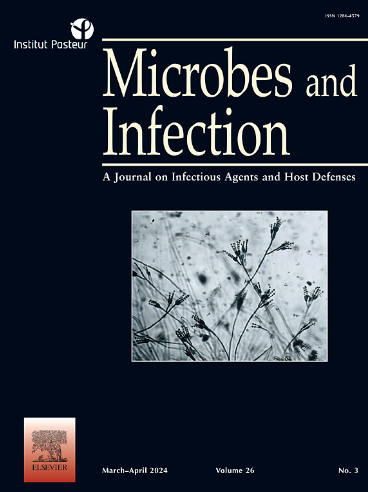Immunostimulatory effects of Hsp70 fragments-modified DCs: A computational and experimental study in HIV vaccine design
IF 2.7
4区 医学
Q3 IMMUNOLOGY
引用次数: 0
Abstract
Background
Dendritic cells (DCs) loaded with HIV-1 antigens have been explored as a promising therapeutic approach to overcome HIV-1 infection. Heat shock proteins (Hsps) can improve cross-presentation of linked antigens by DCs. Our aim was a comprehensive in silico, in vitro, and in vivo evaluation of fusion proteins comprising the N- and C-terminal regions of Hsp70 (i.e., NT-Hsp70 and CT-Hsp70) as an adjuvant linked to HIV-1 Nef antigen in development of DCs-based vaccine candidates.
Methods
Computational analyses of the NT-Hsp70-Nef and CT-Hsp70-Nef fusion constructs were performed, and their structural features and docking ability with toll-like or endocytic receptors were evaluated. The effectiveness of DCs loaded with the fusion proteins in eliciting immunity was assessed in mice. Cytokine secretion levels from splenocytes exposed to single-cycle replicable (SCR) HIV-1 were also measured in vitro.
Results
The DCs pulsed with the fusion constructs induced robust cellular and humoral immune responses in mice and infected splenocytes. The CT-Hsp70 region showed better docking scores with immune receptors and superior adjuvanticity for inducing Nef-specific immune responses (Th1 and CTL activity) compared to the NT-Hsp70 region in DC-based immunization.
Conclusions
The CT-Hsp70-Nef protein demonstrated promising results in both computational and experimental analyses compared to the NT-Hsp70-Nef protein.
Hsp70片段修饰dc的免疫刺激作用:HIV疫苗设计的计算和实验研究
背景:装载HIV-1抗原的树突状细胞(dc)已被探索作为一种有希望的治疗方法来克服HIV-1感染。热休克蛋白(Hsps)可以改善dc对相关抗原的交叉呈递。我们的目的是对Hsp70的N端和c端融合蛋白(即NT-Hsp70和CT-Hsp70)作为与HIV-1 Nef抗原连接的佐剂,在开发基于dcs的候选疫苗过程中进行全面的硅、体外和体内评估。方法:对NT-Hsp70-Nef和CT-Hsp70-Nef融合构建体进行计算分析,评估其结构特征和与toll样受体或内吞受体的对接能力。在小鼠实验中评估了载融合蛋白的树突状细胞诱导免疫的有效性。暴露于单周期可复制(SCR) HIV-1的脾细胞的细胞因子分泌水平也在体外被测量。结果:融合构建的树突状细胞在小鼠和感染的脾细胞中诱导了强大的细胞和体液免疫反应。与NT-Hsp70区相比,CT-Hsp70区与免疫受体的对接评分更高,在诱导nef特异性免疫反应(Th1和CTL活性)方面具有更好的佐剂性。结论:与NT-Hsp70-Nef蛋白相比,CT-Hsp70-Nef蛋白在计算和实验分析中都显示出有希望的结果。
本文章由计算机程序翻译,如有差异,请以英文原文为准。
求助全文
约1分钟内获得全文
求助全文
来源期刊

Microbes and Infection
医学-病毒学
CiteScore
12.60
自引率
1.70%
发文量
90
审稿时长
40 days
期刊介绍:
Microbes and Infection publishes 10 peer-reviewed issues per year in all fields of infection and immunity, covering the different levels of host-microbe interactions, and in particular:
the molecular biology and cell biology of the crosstalk between hosts (human and model organisms) and microbes (viruses, bacteria, parasites and fungi), including molecular virulence and evasion mechanisms.
the immune response to infection, including pathogenesis and host susceptibility.
emerging human infectious diseases.
systems immunology.
molecular epidemiology/genetics of host pathogen interactions.
microbiota and host "interactions".
vaccine development, including novel strategies and adjuvants.
Clinical studies, accounts of clinical trials and biomarker studies in infectious diseases are within the scope of the journal.
Microbes and Infection publishes articles on human pathogens or pathogens of model systems. However, articles on other microbes can be published if they contribute to our understanding of basic mechanisms of host-pathogen interactions. Purely descriptive and preliminary studies are discouraged.
 求助内容:
求助内容: 应助结果提醒方式:
应助结果提醒方式:


